Research Article
THE CHINESE WAY QUALITY REVOLUTION-COUNTRY GOVERNANCE
| Kuan Sheng-Pin* |
| Corresponding Author: Kuan Sheng-Pin, CSQ/QKC, Taipei, Taiwan |
| Received: 01 June 2020; Revised: 19 October 2020; Accepted: 02 February 2021 Available Online: June 4, 2021 |
| Share : |
18734
Views & Citations17734
Likes & Shares
Just as the Chinese community has entered an unprecedented glory in the past 500 years, the term “China's threat” is no longer an academic discourse, but a war of trade and technology. At this moment, the Chinese community should review the history of the past few hundred years, why Chinese rulers have not been able to govern in the current realm of prosperity, in our opinion, there are two major factors. First, the internal friction of the society, in the Ming and Qing Dynasties, the internal friction of maintaining the imperial power; the internal friction of the warlord after the Revolution of 1911; the internal friction of the civil war between the Kuomintang and the Communist Party; and the contradictions between the two sides of the strait each have ideological internal friction. The other is the invasion of the external powers caused by their own internal friction, including their war of aggression and the compensation paid by China, as well as compulsive and unfair economic competition, and even the orientalism under the strong western influence, which has caused China to fall into political chaos and economy. Extreme poverty and cultural identity difficulties.
Countries would enhance their national strength; political stability is more important than economic development. National strength can refer to such hardware power as military affairs, economy, diplomacy, science and technology, and resources as well as software power such as information network infrastructural and cultural level. Among these, military strength, economy, diplomacy and science and technology can all easily enhance the national strength of the country, and political stability plays an important role in elevating the power at these levels. More importantly, the people of the country must unify their opinions so that their power can be concentrated, and rely on the baptism of culture to decide on and strengthen their political direction, keep high economic level to ensure the quality of nationals, take advantage of science technology to ensure a strong state. The people’s spiritual needs should also be uniformed by integrating values, integrating knowledge, integrating ideas and integrating wisdom.
The term “Quality Revolution” first appeared at the Standing Committee of the State Council of China on May 11, 2016, referring to a series of reforms aimed at increasing consumer varieties, improving product quality, creating well-known brands and upgrading people's consumer demand. Taking steps in all sectors to improve quality, we will work toward meeting the highest international standards, encourage the spirit of workmanship, and launch a “Made in China Quality Revolution”.
At this moment, the China proposed the “Made in China Quality Revolution,” which inspired the author's inner world's hope, and thus expanded it into “The Chinese Way Quality Revolution.” When we discuss the issue of economic and social development of a country, with quality as its topic, it will get less controversy in ideology. The quality of the subject to the “essence of substance” requirements are precise, accurate and reliable; to the “process of business” focus on efficiency, effectiveness and value; to the “conduct oneself” emphasis on words and deeds should be consistent; to the “quality of life” pursue the balance of production, ecology and life; to the society “Datong (The Ideal World)” is our dream. Under the guidance of the above-mentioned quality issues, quality professionals are engaged in scientific research, technological development, and application promotion to improve the quality of human life. There will be many projects that can be carried out, especially the establishment of “The Chinese way TQM” and carry out “The Chinese way Quality Revolution”.
Keywords: The Chinese way TQM, The Chinese way Quality Revolution, One Belt One Road, China's threat.
INTRODUCTION
The development and promotion of quality related knowledge and technology is not developed independently, it would be developed accompany with the necessary requirements in politics, economy, industrial, and technology of community, society, region, country, and whole world. Everything should observe the world’s status, see the surrounding situation, know the people's thinking, then can understand the future trends, grasp the precise situation. The principle of the operation of an organization should be based on the trend, to obtain the advantages of future development, and then we can do something meaningful.
Mentioning about “Quality Revolution,” we are also talking about the Revolution of 1911 in China. It has been 100 years since the Revolution of 1911, looking back today; most of the people have a positive attitude toward the Revolution of 1911 and the establishment of the Republic of China. However, China’s fate has not been smooth for a century since the 1911 Revolution, and China has split since then. Based on our own memory and some literatures, we compiled a list of some important events that occurred in the past 70 years, such as Table 1: 70 years of cross-strait political and economic development.
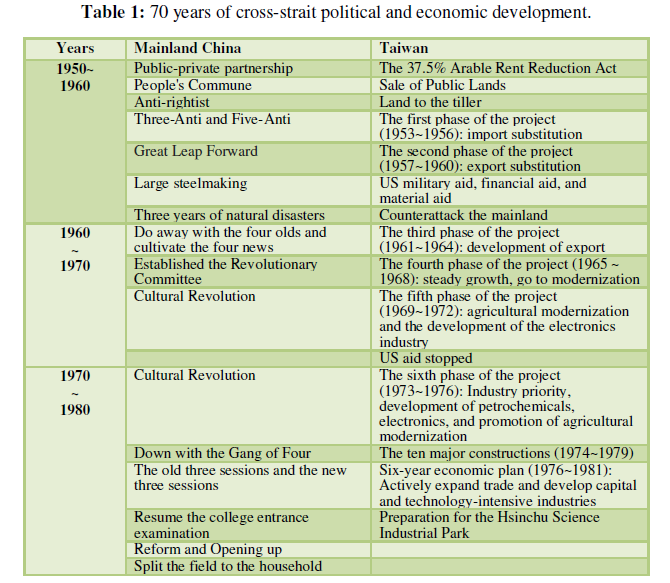
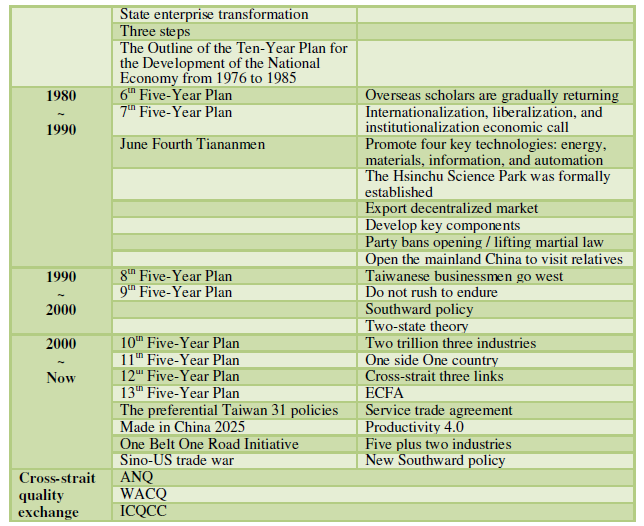


Recently, some famous university experts and scholars from Europe and the United States have discussed the issue of “China's threat” in Amsterdam, Netherlands, and concluded that “China is terrible!” Now translate the summary in the following: (https://user.guancha.cn/main/content?id=52965).
- Adhere to socialism, but do not exclude capitalism, adhere to party leadership, but do not exclude party supervision.
- Applicable economic model, rare in the world. This is not a publicly owned economy, nor a market economy. This mashup model is very effective.
- National patriotism is very rare. They also quarreled inside, but once they met foreign enemies, no one called, and 1.4 billion people were unanimous. The Sade event in the district made South Korea lose two-fifths of the market.
- The top level is dedicated to the people and is very rare in the world. Abolishing agriculture taxation, poverty alleviation, and disaster relief. There is no such thing as ancient and modern, and as China and foreign countries. They do their best.
- The Chinese leadership selection mechanism is rare in the world. The selection of senior Chinese leaders will take more than ten years to investigate, and no interest group can control it.
- The national mechanism is rare in the world. China wants to do anything that they think is important, and it can't do it because they can do all the financial, human, and material resources of the country without any resistance.
- A new generation of young people is becoming a pillar. In China's aerospace, nuclear, electronics, chips, high-speed rail and other fields, the average age of the leaders is only 39.4 years old, 40% of them arestudy abroad returning students.
- China has the most complete industrial system in the world. From making a needle to manufacturing an aircraft carrier, from design to finished product, if they want, no external force is needed.
- China has huge financial inventories. China has nearly 4 trillion US dollars in reserves, purchased US$2.1 trillion in US debt, fiscal surplus, bank deposits and other reserves totaling about 8 trillion yuan. Its financial real ability is the sum of Europe, America, Japan and Russia.
- The world of Chinese brand innovation is rare. The world refers to individual excellent products as brands, while China uses a brand-new business model as a brand, e-commerce, Alipay, shared bicycles, andMeituan Delivery. The business models they created in a short period of time and create rare value.
- China has rare macro-control capabilities. The Asian financial turmoil and the US subprime mortgage crisis have not had an impact on China, and the crisis that he may form is quickly being reduced.
- China has a huge market. He can completely promote the market by self-consumption, and at the same time, he can drown the market that they think is harmful.
- After China has thought of things for decades, this is unique in the world. China has five-year and ten-year plans, one belt and one road, and may be a 50-year plan. This kind of anticipation, prejudgment, presupposition ability is the basis for dealing with any kind of crisis.
- Good decisions are passed down from generation to generation, it is rare in the world. In many countries, different president has his own idea, in China, to serve the people, to reform and opening up, it has been used for decades, and to use generations of generations, Zhou Enlai’s Bandung Society’s peaceful coexistence of five foreign policies is still China’s diplomatic principles. This is the embodiment of a responsible and trustworthy power.
- No one can shake the strength of China's vast infrastructure development. China's development in the past 40 years, she is not a certain aspect of development, but a comprehensive development, even if it is not the best in the world, but definitely the world's most potential.
China is terrible, and the threat from her is also this. If she does not have problems, who can kill her? Her growth and strength, no one can stop.
Although some of the above statements are considered to be fake news, from the standpoint of Chinese society, we hope that the Communist Party of China will really be like this. At this moment (around 2020), when the Sino-U.S. Trade war is in full swing, it is the right time to discuss this issue, and the media community reports on the economic and technological wars between countries. Even the academia used a plausible historical law “Thucydides Trap” to predict that a newly rising power must challenge the existing power, and the existing power must also respond to this threat, so the war becomes inevitable.
THE STORIES OF “THE RISE OF THE GREAT POWERS”
“The Rise of the Great Powers” is a 12-part Chinese documentary television series produced by CCTV. It was first broadcast on CCTV-2 from 13 to 24 November 2006. It discussed the rise of nine great powers: Portugal, Spain, Netherlands, United Kingdom, France, Germany, Japan, Russia (Soviet Union), and United States.
After the film was broadcast, CCTV cooperated with China Democracy and Law Publishing House to launch a series of eight books of the same title with a large-scale expansion; and from 20:55 on May 1, 2007, prime time CCTV-1 broadcast again. The 12th part “Thoughts on the Great Path: Conclusion” stated as following. The strength of a nation must unify the opinions of its constituent peoples so that power can be concentrated and, by means of cultural baptism, the political direction of correcting itself can be determined and strengthened. With the favorable economic capability, the survival of the people, the use of science and technology advantages to ensure the countries strong. State and country get along with the same as between people, conflicts between people will fight, between countries is a war, people will become a long time between the tribe, being a nation, a long-standing relationship between nations will create a federation. In today's world, because of the development of science and technology, the distance between countries is getting closer and the economic cooperation is getting more and more frequently, even it is getting worse and worse, should not be solved by force. It is the responsibility of all countries to play their role in an integrated world.
If you want to see the complete films, please watch videos on YouTube. And try to understand the reason why China authority produced this film, please refer to the paper “The Rise of Nations and the Historical Perspective of the Rising China” by Professor Mao Han-kuang, honorary professor at the Department of History and Research at National Chung Cheng University. (kuang, 2012) He did even more on the comparative analysis of the history of China and foreign countries. Why China did not have a chance to become a world power in these five hundred years (1500-2000)? Finally, on the factors and conditions of the rise of great powers, were listed as the following:
- The mainstream elite of a power can grasp the conditions of good timing, geographical convenience and good human relations, and fulfill the ideal of decisiveness.
- Structural changes such as politics, economy, science and technology have made the overall national power surpass the ancient of her own country, and surpass other countries.
- The rise of a great power enhances the happiness of the nation internally and maintains the harmony of other countries externally.
- The rise of great powers or the appearance of Charisma characters, centralized Central Government, however, in the second wave of maintenance and construction, there was no transition to collective leadership or parliamentary politics or to most public opinion policing, then sudden rise in the final sharp decline.
- Cultural thinking cannot tie the domestic public together, causing tensions in other countries. When rising, it will slow down the time and strength, or decline from prosperity.
- Core cohesi
We are fortunate to experience the rise of the Chinese society in the past 100 years from the colonial powers and aggression, the eight-year war of resistance, the civil war between the Kuomintang and the Communist Party, the opposition between the two sides of cross-strait, the war is still latent, the rise of the Asian four small dragons in the emerging industrial countries, and the rise of the Chinese mainland. The Chinese society has gradually caught up with advanced countries such as Europe, the United States, and Japan, and has gradually come to the forefront from the viewpoint of food and clothing, social stability, political harmony, economic development, and scientific and technological progress to a well-off society.
At this moment, the global spread of the new coronavirus (COVID-19) is what we have not experienced in our lifetime, affecting the world’s largest global pandemic event. In human history, even the two world wars have not affected such a wide geographical range. Some people say: “This is a war without smoke, which affects the life of all people; this is a war where the enemy is vague. We still cannot describe the whole picture of the appearance of the virus. For the same reason, we are facing a war of unprecedented war.”
As for how to deal with the epidemic situation of the COVID-19, humans always have a solution, stop its spread in a short period of time, reduce its harm, stabilize the social order, and avoid unrest at all levels; in the long term, recognize the virus and develop vaccine treatments to avoid infection or effective cure; this is the basic knowledge that our general intellectuals should have. The impact of the epidemic has been commented by many media on the website, we will not repeat here, but our thinking way has been a certain influenced, and it should be adjusted. For example, open, prosperous, and democratic freedom national social development; globalization, international mobility, and global activity trends in the global village; Mainland China’s global positive and negative influences are more prominent; what we have recently written “The Chinese Way Series” are at the right time. Regarding this global pandemic event, we personally estimate the post-war world after the COVID-19. The heavy damages have not been spared everywhere in the world; the longer the delay, the more serious the damage; the last one to see who is hurt lighter; and the right to speak in the world will be reshuffled.
MADE IN CHINA “QUALITY REVOLUTION”
China follows the same roadmap, principle and policy of governing Deng Xiaoping 50-year reform and opening up policy in 1992. After the 9th, 10th, 11th and 12th Five-Year Plans, China is now implementing the 13th Five-Year Plan aims at “building a well-to-do society in an all-round way” and proposes the five development concepts of “innovation,” “coordination,” “greenness,” “openness,” and “sharing.” The transformation of China's internal manufacturing to China is the general trend of the three major changes, to push forward “the transformation from China Speed to China Quality, from Made in China to Created in China, and from Chinese Products to Chinese Brand.” “Three Transformations” are the specific requirements and goal of China’s national. For the opening up, the promotion of Vision and Action of Building Silk Road Economic Belt and 21st Century Maritime Silk Road (One Belt One Road), it focuses on the Asian, European and African continents, but is also open to all other countries. All countries, from Asia, Europe, Africa or the Americas, can be international cooperation partners of One Belt One Road Initiative. The pursuit of this initiative is based on extensive consultation and its benefits will be shared by all of us.
China has implemented this kind of Total Quality Management (TQM) mode of administration with a huge number of state machines. In the past 30 years, hardly have any countries in the world could pass through on this way. When we regard democratic freedom as a universal value, she insists on the party leadership and services the people. In mainland China, politics is more important than the economy because China takes the party leadership and politics determines the direction of the economic development.
The term “Quality Revolution” first appeared at the Standing Committee of the State Council of China on May 11, 2016, referring to a series of reforms aimed at increasing consumer varieties, improving product quality, creating well-known brands and upgrading people's consumer demand. Taking steps in all sectors to improve quality, we will work toward meeting the highest international standards, encourage the spirit of workmanship, and launch a “Made in China Quality Revolution.” (Launched a quality revolution in China).
What is going on here is the quality revolution of technological development. Recently, China’s telecom manufacturer ZTE has been caught in a production dilemma because it violated the trade injunctions with Iran and North Korea and was ruined by the United States to completely block and cut off core chip technology. What's more, the arrest of Cathy Meng, vice chairman and CFO of Huawei, the daughter of founder, caused the US-China trade conflict to rise again. This force not only indirectly kills the future of China's 5G communications and the vision of “Made in China 2025”, but now also causes Chinese online media to collapse. There is an ancient motto: “People are more self-aware then more self-conscious,” this kind of introspection ability, from the development of personal career to the governance of the state, is very important. If without knowing the strengths and weaknesses of the self and the external opportunities and threats, how to provide the effective strategies.
Among the current strategic planning tools, SWOT analysis should be considered one of the most widely used tools, which was established by McKinsey & Company. (The world's largest strategic consulting company). Including analysis of the company's internal strengths and weaknesses; analysis of the company's external opportunities and threats, through SWOT analysis, will analyze all aspects of the internal and external conditions of the enterprise, and then summarize the organization's strengths, weaknesses, opportunities and threats. Systematically focus resources and actions on their strengths, invest in the opportunities; and allow companies to strengthen or avoid weaknesses, control or reduce the risk of external threats.
On April 25, 2018, the heading of Yanhuang Chunqiu Newspaper (炎黃春秋報) “In addition to the core chip, China's 24 core technologies are not mastered.” Speaking: China's core technology is subject to others for a long time! The first step in solving this problem is to find out exactly which China is behind others and in which areas, seeing the direction can be stable and far-reaching. The core pain point of China's communications industry - the problem of “the lack of core and less soul” is once again severely placed in front of China. Table 2 shows the 24 core technologies listed in the article except the core chip.
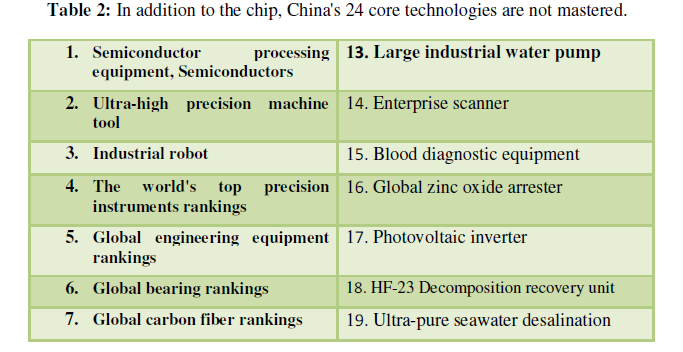



TECHNOLOGY REVOLUTION
In fact, compared with developed countries, there is still a clear gap between China's manufacturing industry's innovation capability, overall quality and competitiveness. It is big but not strong.
Through the efforts of three decades, to achieve Three Transformations: “the transformation from China Speed to China Quality, from Made in China to Create in China, and from Chinese Products to Chinese Brand,” to complete the Chinese manufacturing from “big” to “strong” strategic task. Made in China 2025 focuses on economic and social development and major national security needs, selects 10 major advantages and strategic industries as breakthrough points and strives to reach the international leading position or international advanced level by 2025. Ten key areas are: a new generation of information technology industry, high-end CNC machine tools and robots, aerospace equipment, marine engineering equipment and high-tech vessels, advanced rail transport equipment, energy saving and new energy vehicles, electrical power equipment, agricultural equipment, new materials, biomedicine and high-performance medical equipment.
ANQ Congress 2015 Taipei, Professor Tony Chen invited a group of Professor Zhang Genbao from the School of Mechanical Engineering of Chongqing University to attend the conference. After the Congress, “ANQ 2015-Reliability Seminar on Digital Machine Tool of Cross-Straits” was held. On the seminar, Professor Zhang Genbao gave a speech on the topic: “The current status and development of the reliability of the machine tool in China,” which mentioned that the quality of the domestically produced machine tools made me impressed. And put forward the countermeasures of the 8341 projects, as shown in Figure 1 and Figure 2. The following is the summary of what he said:
Most people think that the main reason why the quality of China’s machine tool problem is the design ability not strong! I don't think so! The crux of the problem is that if the same process file is handed over to our machine tool companies and German machine tool companies at the same time, the appearance of the products can be similar, the functions can be the same, the structure can be similar, but stability and reliability are completely different!
Therefore, we are not afraid of innovation, because:
- The appearance can be imitated! (strong imitation ability)
- Functions can be copied! (strong plagiarism)
- The structure can be reversed! (reverse engineering)
- Design drawings can be purchased! (rich in funds)
- Process files can be purchased! (rich in funds)
- Millet phone is typical!
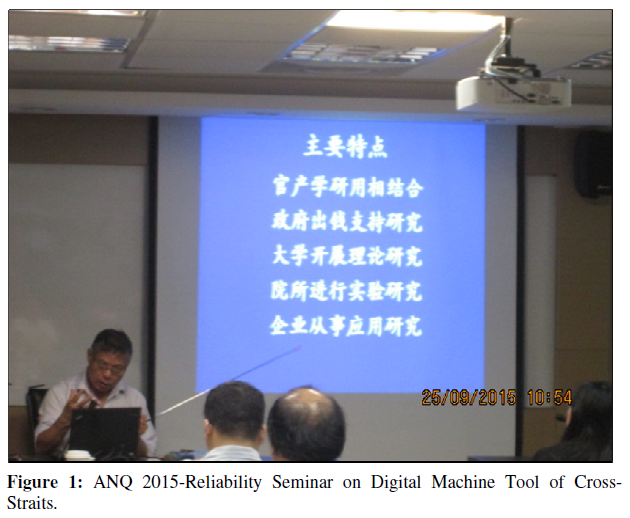
But what's worse is that reliability and stability can't be imitated; it's impossible to copy; it's impossible to reverse; it can't be bought by spending money! Only by our own efforts, we will explore ways to improve reliability and quality stability! In addition, regardless of product, quality and reliability must be high!
According to Professor Zhang Genbao's so-called “8341 Project”, there seems to be no shortcut to the quality revolution. It must be based on the development of the quality professional field. After years of professional integration in different fields, gradually formed as multi-value organization team operation mode, such as continuous improvement, leadership, consistent goals, full participation, common language, technology sharing, change management and culture heritage. An organization can be able to operate sustainably, in particular, the commitment, knowledge and active participation of high-level leaders are the key. First, they must be established a business philosophy from high-level leaders, integrate ideas within the organization, form a consensus, and then can be able to build up sustainable operating mechanism.
Back to the source, W. A. Shewhart has an example in his masterpiece, “The Economic Control of Quality of Manufactured Products” p.326, which explains the quality of a telephone. It refers to a carbon-grain microphone that converts sound into electronics. The sensor of the signal consists of two separate foils and carbon particles between them. The piece of metal foil facing outwards acts as a conductive diaphragm. When the sound vibrates the foil, it changes it pressure on the carbon particles, which further changes the voltage between the two foils. Three factors affect the quality of the carbon-grain microphone, carbon particles, foils and assembly, as shown in Figure 3.
If the variation of the carbon particles is , the variation of the metal foils is
, the variation of the metal foils is  , and the variation of the assembly is
, and the variation of the assembly is  , the variation of the carbon-grain microphone is
, the variation of the carbon-grain microphone is  .
.

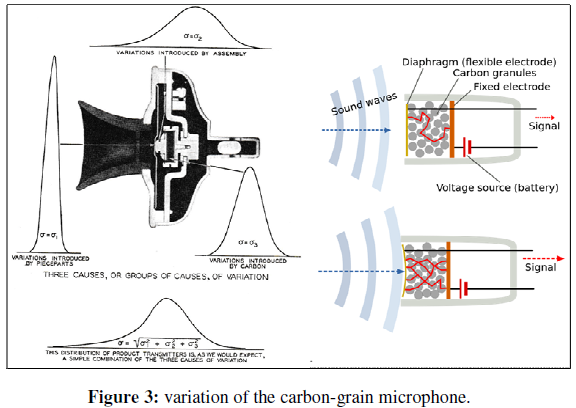
If the variation of the carbon particles is
 , the variation of the metal foils is
, the variation of the metal foils is  , and the variation of the assembly is
, and the variation of the assembly is  , the variation of the carbon-grain microphone is
, the variation of the carbon-grain microphone is  .
.

“Close to Academician”: Liu Yuanzhang: China's “factory doctor.” In the article, Liu Yuanzhang, the father of Chinese quality, told a story:
His first test was completed in 1957 at the Shanghai State-owned Second Textile Machinery Factory. The main product of this factory is the textile machine, one of which is the key component of the fine grinding process. Liu Yuanzhang saw in the workshop that the operator who worked on the grinding machine was an old master. Every time he finished grinding one piece, he handed it over to the young master. After the young master accurately measured the product dimension, he told the old master whether it was thick or thin. Liu Yuanzhang draws the data measured by the young master into a trend chart according to the processing order, and then asks the old master to process it alone without the help of the young master, and then draws the finished product data into a trend chart. It is clear from the charts that the data of both processing fluctuates around the standard dimension. However, the fluctuation of the processing time of the old master alone is obviously much smaller than when they cooperate. The reason is that the old master is rich in experience, when the young master is on the side, he interferes with the old master’s operation (Pin, 1997).
Liu Yuanzhang explained through this small example that quality control is not a traditional simple statistical test. Instead, it controls the factors affecting product quality in the production process through the principle of mathematical statistics, so as to make the product quality fluctuate in every key characteristic as much small as possible. Ultimately achieve stable, high-quality production on the whole.
Design and development of various new products, in particular Original Equipment Manufacturers (OEM) or Original Design Manufactures (ODM) of design manufacturing parts, the product and process quality planning must be established and maintained a series documents to control and validate the product. And the planning process must be ensured that the requirements of the customer to be satisfied. Advanced Product Quality Planning (APQP) is generally used as a reference for designing manufacturing parts.
APQP divides planning process into planning and evaluation phase, product design and development phase, process design and development phase, product and process validation phase and mass production phase. The quality related methodologies Inter-relationship diagraph of each phase are shown in Figure 4. The new Global Automotive Quality Management System standard was released by IATF (International Automotive Task Force) in October 2016 and renamed IATF 16949: 2016. This will replace the current Quality Management System (QMS) requirements defined in the ISO / TS 16949 automotive industry. For its evolution, please refer to Figure 5. It is related five core tools: APQP / FMEA / MSA / SPC / PPAP, and APQP is one of the most important core tools.
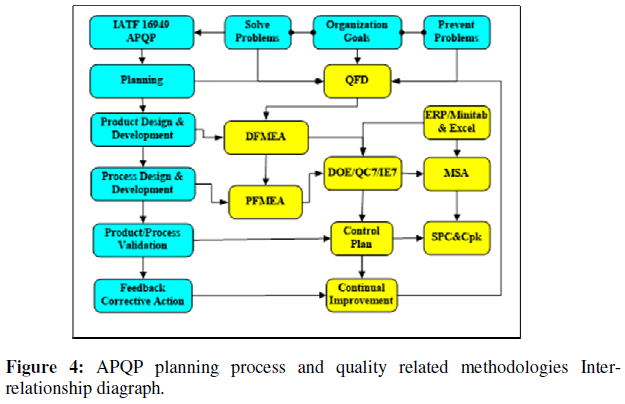

The title of the quality revolution of technology development is to remind design engineers that quality is designed. Whether you are doing research, technology transfer, or mass production, finally, it is necessary to communicate via a documented system, such as the APQP system. The so-called “Do not do evil things though it may be insignificant, do not give up good things though it may be minor matters;” “small things are not small;” “the devil always hidden in the details.” That is to say, there is no shortcut to technological development, only the implementation is in place. Taking the ideas of quality gurus W.A. Shewhart and Liu Yuanzhang as examples, they also informed design engineers to solve quality problems from the source of the root causes that affects quality.
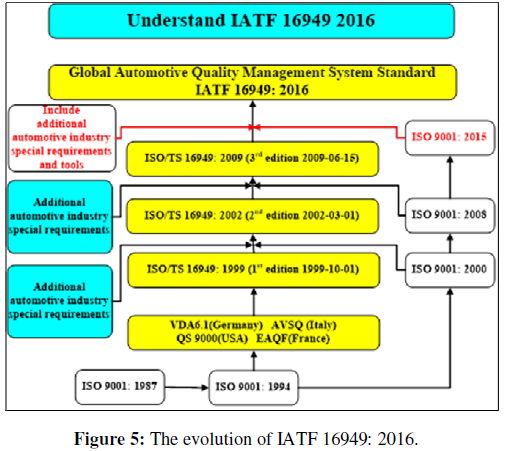
THE CHINESE WAY TOTAL QUALITY MANAGEMENT
The Chinese community, Singapore, Hong Kong and Macao regions are well-established in the financial and service industries, and its quality standards have reached the world's advanced level; ICT industry is the most complete in Taiwan; and the rising of Mainland China. Just as the Chinese community has entered an unprecedented glory in the past 500 years, the term “China’s threat” is no longer an academic discourse, but a war of trade and technology. At this moment, the Chinese community should review the history of the past few hundred years, why Chinese rulers have not been able to govern in the current realm of prosperity, in author’s opinion, there are two major factors. First, the internal friction of the society, in the Ming and Qing Dynasties, the internal friction of maintaining the imperial power; the internal friction of the warlord after the Revolution of 1911; the internal friction of the civil war between the Kuomintang and the Communist Party; and the contradictions between the two sides of the strait each have ideological internal friction. The other is the invasion of the external powers caused by their own internal friction, including their war of aggression and the compensation paid by China, as well as compulsive and unfair economic competition, and even the orientalism under the strong western influence, which has caused China to fall into political chaos and economy. Extreme poverty and cultural identity difficulties.
Countries would enhance their national strength; political stability is more important than economic development. National Strength can refer to such hardware power as military affairs, economy, diplomacy, science and technology, and resources as well as software power such as information network infrastructural and cultural level. Among these, military strength, economy, diplomacy and science and technology can all easily enhance the national strength of the country, and political stability plays an important role in elevating the power at these levels. More importantly, the people of the country must unify their opinions so that their power can be concentrated, and rely on the baptism of culture to decide on and strengthen their political direction, keep high economic level to ensure the quality of nationals, take advantage of science technology to ensure a strong state. The people’s spiritual needs should also be uniformed by integrating values, integrating knowledge, integrating ideas and integrating wisdom. The so-called “The Chinese Way Total Quality Management” (Kuan, 2018; Pin, Linn, 2019) under the theoretical basis of new structural economics, gradually sort out a specific architecture as follows:
- TQM with the party leading the government;
- Establish a constitutional level of roadmap, principle and policy;
- Macro-control and micro-correction under country governance with PDCA;
- Launch the ministry, province, city and autonomous region with the vision, goals and strategies formed by the Party Central Committee;
- Combination of government, industry, and research institute, government support for research, universities focus on theoretical research, institutes focus on experimental research, and enterprises focus on realizational research;
- From the Party Central Committee, the State Council, the Military Commission, the Disciplinary Committee, and the legislators to the ministries, provinces, municipalities, autonomous regions, counties, cities, towns and peoples, the people's ideas are consistent;
- People-centered socialist comprehensive modernization;
- The continuous improvement of bottom-up self-discipline should be the first priority.
CONCLUSION
When we discuss the issue of economic and social development of a country, with quality as its topic, it will get less controversy in ideology. The quality of the subject to the “essence of substance” requirements are precise, accurate and reliable; to the “process of business” focus on efficiency, effectiveness and value; to the “conduct oneself” emphasis on words and deeds should be consistent; to the “quality of life” pursue the balance of production, ecology, life; to the society “Datong (The Ideal World)” is our dream. In terms of economic and social development, the Chinese community in Singapore, Hong Kong, Macao, Taiwan and Mainland China promotes “The Chinese Way TQM” in order to avoid internal friction and carry out the quality revolution of technological development. Technology can compete with other powerful countries and even surpass it to resist foreign aggression.
Guided by the above quality issues, quality professionals may can be dedicated to that: “for satisfying the universal value of human material and spiritual needs, integrate the methodologies of essence of substance, process of business and psychology, for enhancing the quality of human life, to engage in quality related science research, technology development, and application promotion.” There will be many projects to be carried out, especially the establishment of “The Chinese Way Quality Revolution.”
- https://user.guancha.cn/main/content?id=52965.
- https://youtu.be/P9ebJ3eJCrI?list=PLwXMmy5fUrVzrhuQ4Bp-CB9qIN1rOmhdf .
- kuang, M.H. (2012). The Rise of Nations and the Historical Perspective of the Rising China, CY Journal, ISSN 1026-244X, seventeenth Vol. (朝陽學報第十七期), pp 65-88.
- Launched a quality revolution in China, China Daily. 2018-03-08. Available online at: http://language.chinadaily.com.cn/2018npc/2018-03/08/content_35810501.htm.
- The world's largest strategic consulting company. Available online at: http://mckinseychina.com/zh.
- The meaning of this mysterious number 8341: Mao Zedong lived 83 years old (1893-1976) and led the Communist Party of China for 41 years (1935-1976).
- "Close to Academician": Liu Yuanzhang: China's "factory doctor", Chinese People's Party newspaper reporter Li Shuya. Available online at: http://www.chinapictorial.com.cn/ch/se/txt/2013-05/30/content_545557.htm.
- Pin, K.S. (1997). Funnel Experiment - Process Monitoring and Adjustment, CSQ "Quality Monthly", 32 (8), p.52~p.59.
- Kuan, S.P. (2018). The Chinese Way TQM, LAP LAMBERT Academic Publishing (2018-02-20).
- Pin, K.S. & Linn, P.H. (2019). The Chinese Way Total Quality Management, Journal of Business and Economics 10(1).






